Selection criteria for kitchen flooring?
The room where food is prepared is much more prone to contamination than the rest of the rooms in the apartment, which means the floor should be:
- Durable to withstand frequent washing and cleaning with household chemicals.
- Durable to withstand continuous stress.
- Fireproof: When exposed to high temperatures, it is important that the floor does not emit toxic fumes and also does not ignite.
- Moisture-proof: the porous coating absorbs moisture and grease and promotes the development of various microorganisms, which should not be in an apartment.
What kind of floor can I use?
Before laying any material, it is necessary to make waterproofing, which will increase the protection of the room from water, and level the base. Consider the most popular and practical types of kitchen flooring.
Linoleum
Inexpensive material with a lot of advantages. It fits exclusively on a flat prepared surface, otherwise all dents and irregularities will be noticeable. The wear of the coating depends on its characteristics: for the kitchen, you should choose class 31-34, which will last about 15 years.
In the photo there is a loft-style studio kitchen. The floor is covered with wood imitation linoleum.
Linoleum has both pros and cons, let's consider them in more detail:
| Dignity | disadvantages |
|---|---|
| It is water-repellent. If a dishwasher or washing machine leaks, it will be easy to remove the water. | You can find a budget option, but this material does not have a wealth of colors. |
| In order to lay linoleum, no special skills are required. | Linoleum less than 2 mm thick dents from heavy furniture. |
| It is not subject to scratches, and if glassware falls, there will be no dents on a high-quality coating. | Deforms over time. Replacement requires the entire canvas. |
| It has good sound insulation. | Poor-quality coating does not imitate wood and stone poorly. |
Laminate
Quite an acceptable option for the kitchen, if you do not choose too cheap material (33 grade is suitable). It has many textures and colors, it can look like natural parquet.
In the photo there is a kitchen in the style of a modern classic, the floor of which is covered with laminate.
What other features does it have? The answers are given below:
| Dignity | disadvantages |
|---|---|
| Even a beginner can lay the laminate. | Amplifies footstep sounds if no mounting backing is used. |
| Water resistant the laminate will not deform even after water ingress. | Moisture resistant the material is not afraid of high humidity, but over time it begins to swell and rot if water flows into the seams. |
| Durable, won't scratch, won't fade. | Laminate joints for kitchens are recommended to be treated with a transparent sealant. |
| Easy to clean, comfortable to touch. |
I advise you to look in more detail about features of the selection of laminate for an apartment.
Tiles and porcelain stoneware
The most practical option for a kitchen floor. Tiles are quite slippery and less durable, and cracks may appear on them during use.Porcelain stoneware is more resistant to mechanical stress and does not fade. Recommended choose a dark groutso that dirt between the seams is less visible.
In the photo there is a Provence style kitchen, the floor of which is decorated with ceramic tiles with a patchwork pattern.
Let's consider the operational characteristics of porcelain stoneware in more detail:
| Dignity | disadvantages |
|---|---|
| Durability, resistance to chemicals. | It is difficult to lay tiles without special preparation. |
| A wealth of colors, shapes and sizes. Can imitate wood, stone. | If the room is not equipped with a floor heating system, the surface will be cold and unpleasant for the feet. |
| Resistant to dirt, moisture, grease. | Low sound insulation. |
| Environmentally friendly material. | There is a high chance of chipping if something heavy falls to the floor. |
Wooden floor
This segment is represented by natural wood materials: parquet and deck boards. Most designers love this floor, but not all consider it suitable for the kitchen.
In the photo there is a Scandinavian-style kitchen, the floor of which is covered with natural boards. They soften the austere atmosphere and add coziness to the interior.
We weigh all the pros and cons of wood flooring:
| Dignity | disadvantages |
|---|---|
| Environmentally friendly material. | Absorbs water droplets, grease and odors. The tree is difficult to care for. |
| Expensive wood species are highly durable and aesthetically pleasing. | To increase the durability of the parquet, it is necessary to cover it with a special protective compound. |
| The surface is pleasant and warm to the touch. | The seams between the boards diverge over time, water and dirt easily penetrate there. |
Self-leveling floor
A relatively new and expensive way to decorate your kitchen floor. As a result of pouring, a homogeneous glossy surface is obtained without seams and drops.
The photo shows a modern kitchen with a white self-leveling floor.
Consider the pros and cons of a polyurethane coating:
| Dignity | disadvantages |
|---|---|
| A huge selection of colors - any image is applied to a non-woven synthetic material, after which it is filled with a mixture. | Time-consuming preparation of the base for pouring. |
| Easy to clean, scratch resistant, shockproof. | High price. |
| Possesses good moisture resistance. | Any dirt is visible on the glossy surface. |
| The polymer floor is durable and can be repaired if damaged. |
Cork floor
Elastic material in rolls or slabs made from shredded wood. Compressed with thermosetting resins, the coating is elastic and rough. The surface is covered with special protective compounds.
It is worth getting to know the unusual material better:
| Dignity | disadvantages |
|---|---|
| The cork is silent, absorbs sounds well. | Does not withstand prolonged exposure to water. |
| Does not absorb odors and grease, is not susceptible to fungus, is safe. | |
| Wear-resistant, not deformed. | Dents from impacts from heavy objects are possible. |
| It has good thermal conductivity. |
Combined floor
Some kitchen owners combine two materials with each other in order to make the floor as practical as possible without giving up their useful properties. As a rule, wood or linoleum is combined, covering the dining area with a warmer coating, and the tiles are laid in the cooking area.
There are several reasons for this decision:
| Dignity | disadvantages |
|---|---|
| The combined floor combines all the advantages of different types of flooring. | It is problematic to disguise the joint, moreover, dirt and dust accumulate in it. |
| In a spacious kitchen, it acts as an excellent zoning method. | This option is not suitable for cramped kitchens. |
| If you plan to install a warm floor, you can save a certain amount by reducing the area. | You need excellent taste or the help of a specialist to successfully combine the two materials. |
What is better to make a floor: a comparative table
This table summarizes the characteristics of each kitchen flooring:
| Material | Linoleum | Laminate | Tile | Wood | Bulk | Bung |
|---|---|---|---|---|---|---|
| Environmental friendliness | + | + | + | + | – | + |
| Transportation | + | + | + | + | – | + |
| Installation | + | + | – | + | – | + |
| Appearance | + | + | + | + | + | + |
| Wear resistance | + | – | + | – | + | + |
| Maintainability | – | + | – | + | + | – |
| Noise isolation | + | – | – | – | + | + |
| Thermal conductivity | + | + | – | + | – | + |
| Ease of cleaning | + | + | + | – | + | + |
| The cost | + | + | – | – | – | + |
See also how to combine tiles and laminate in the kitchen.
Today, the construction market allows you to choose flooring without sacrificing aesthetics for the sake of practicality: kitchen owners can only decide on their preferences and budget.

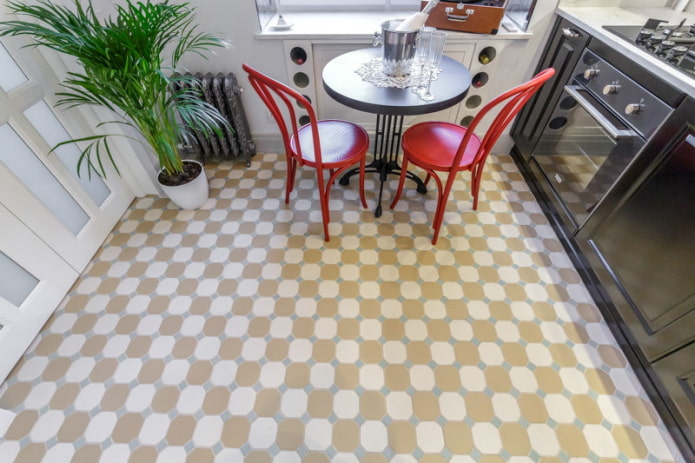
 10 practical tips for arranging a small kitchen in the country
10 practical tips for arranging a small kitchen in the country
 12 simple ideas for a small garden that will make it visually spacious
12 simple ideas for a small garden that will make it visually spacious

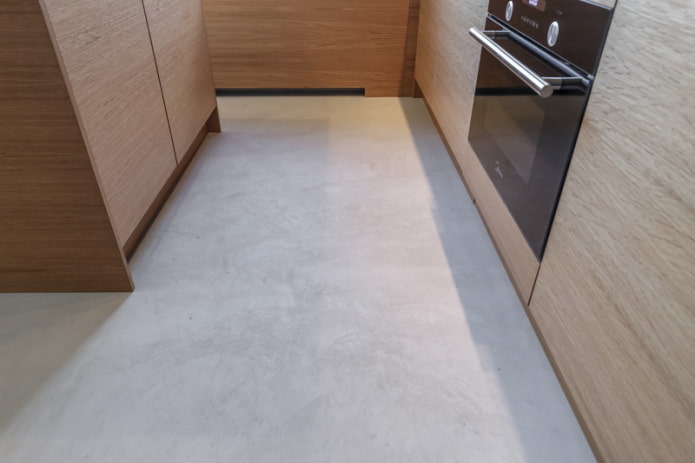
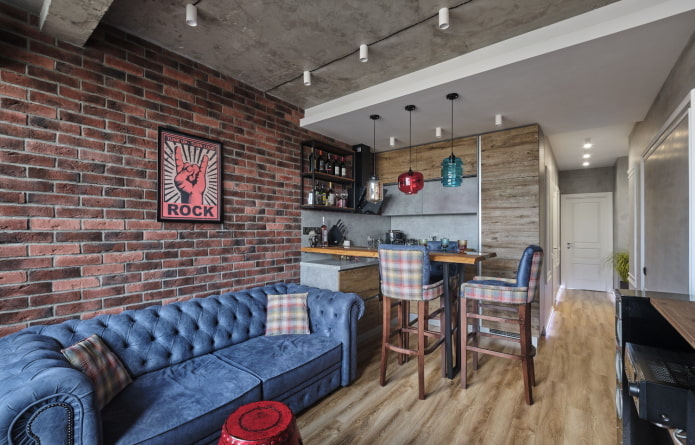
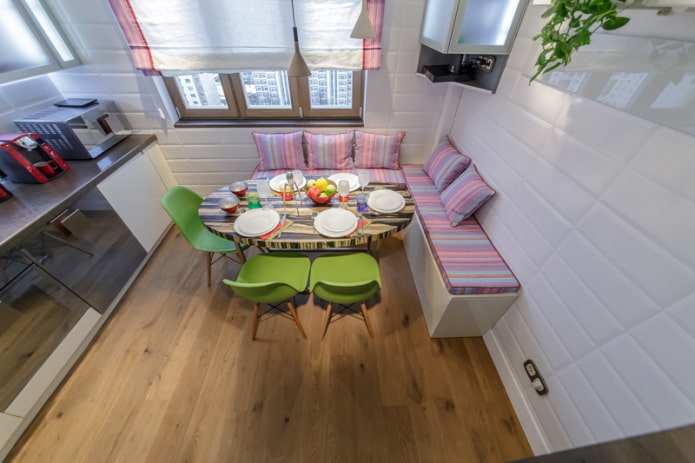
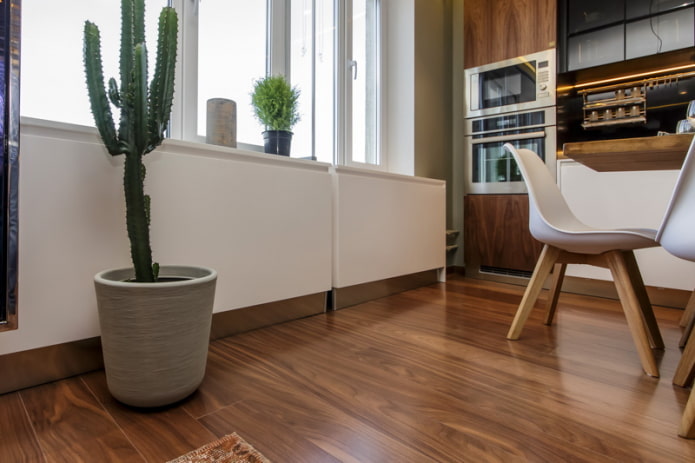
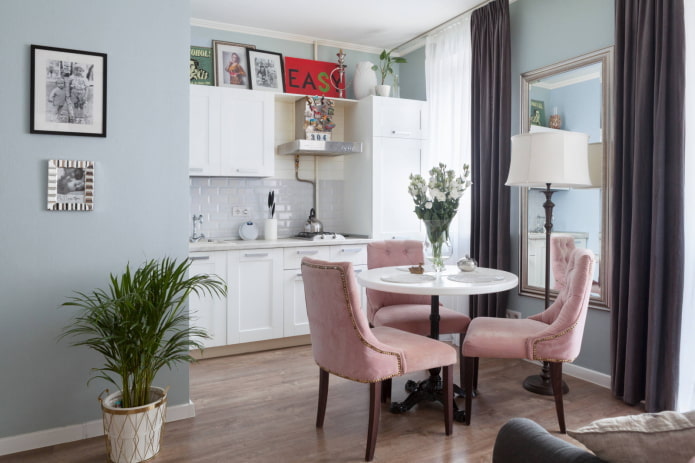
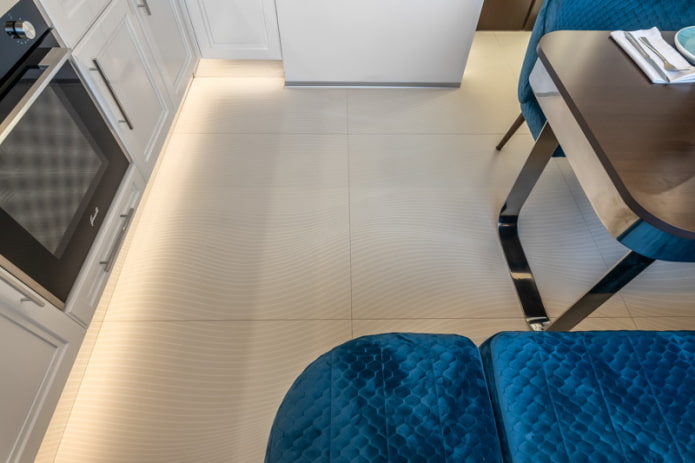
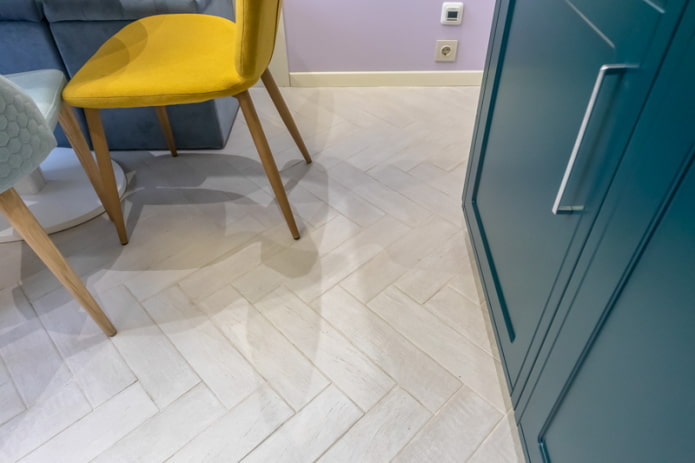
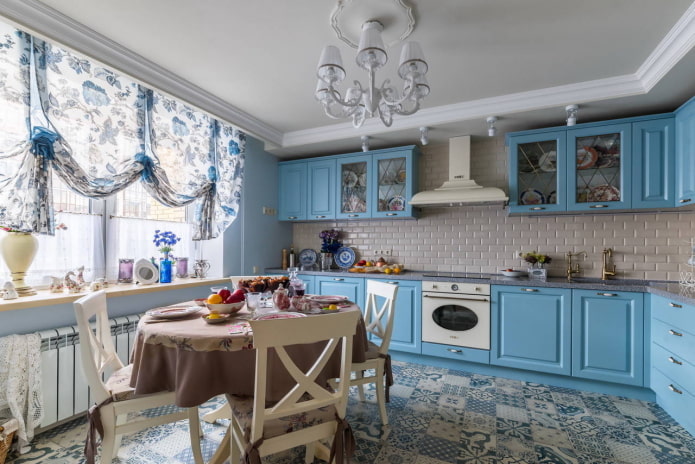

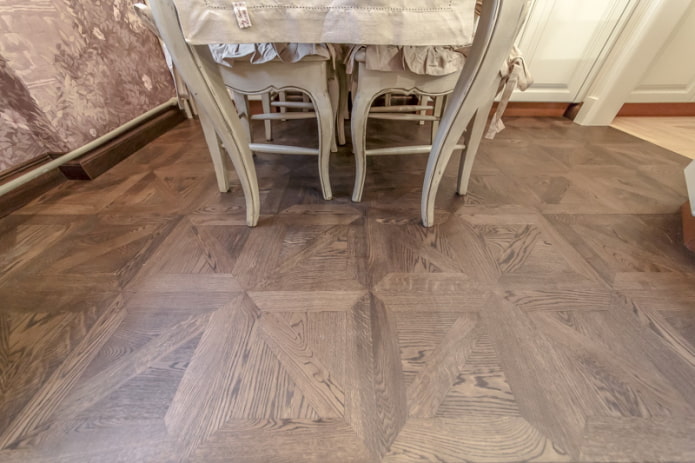
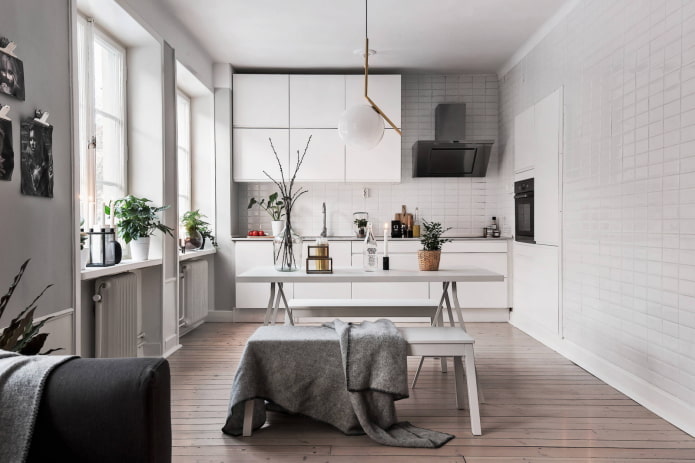


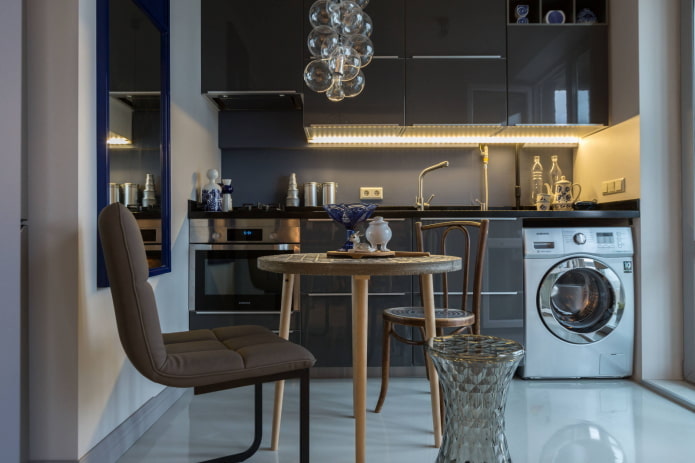
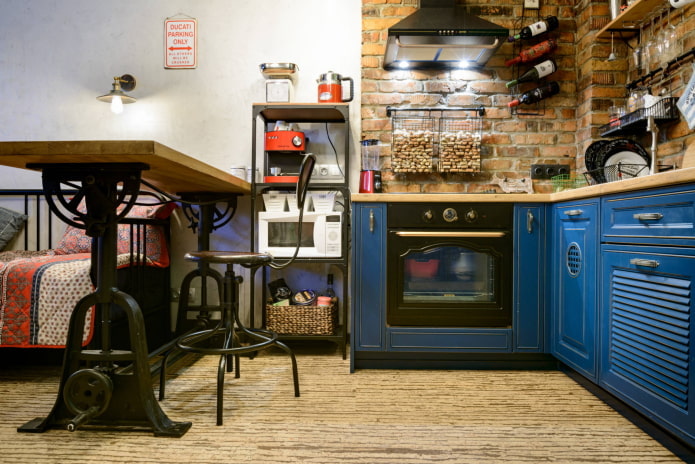
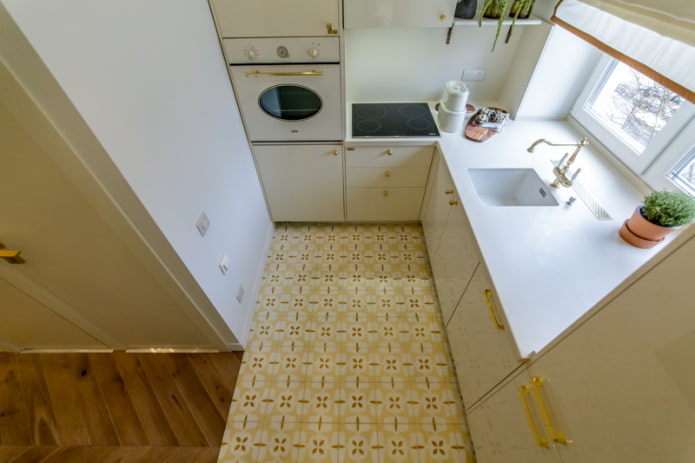
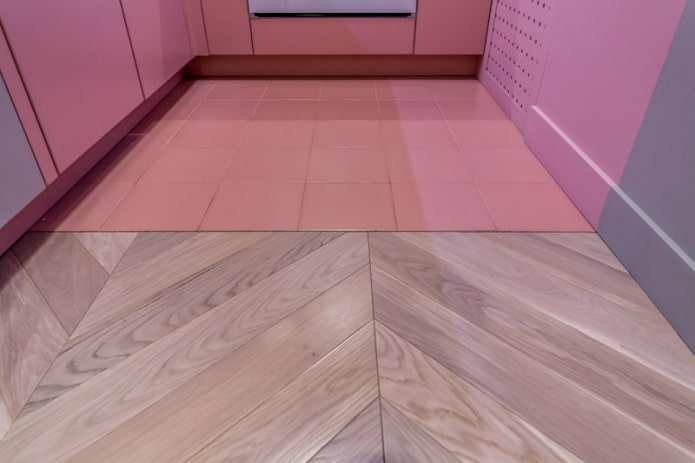

 How to choose the color of your kitchen sink?
How to choose the color of your kitchen sink? White kitchen set: features of choice, combination, 70 photos in the interior
White kitchen set: features of choice, combination, 70 photos in the interior Black set in the interior in the kitchen: design, choice of wallpaper, 90 photos
Black set in the interior in the kitchen: design, choice of wallpaper, 90 photos How to choose curtains for the kitchen and not regret it? - we understand all the nuances
How to choose curtains for the kitchen and not regret it? - we understand all the nuances Design of a white kitchen with a black countertop: 80 best ideas, photos in the interior
Design of a white kitchen with a black countertop: 80 best ideas, photos in the interior Kitchen design with green wallpaper: 55 modern photos in the interior
Kitchen design with green wallpaper: 55 modern photos in the interior